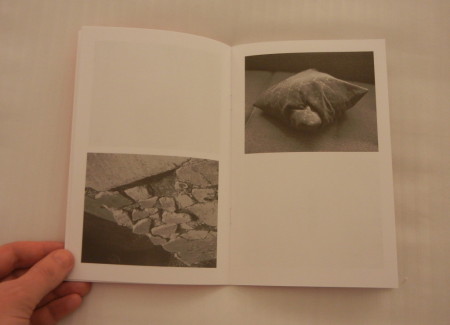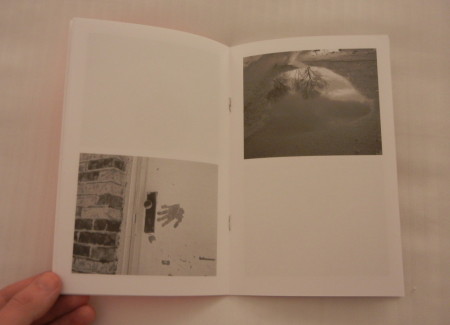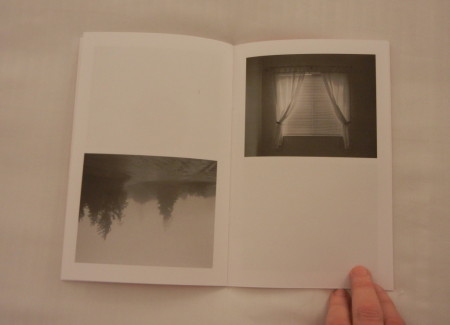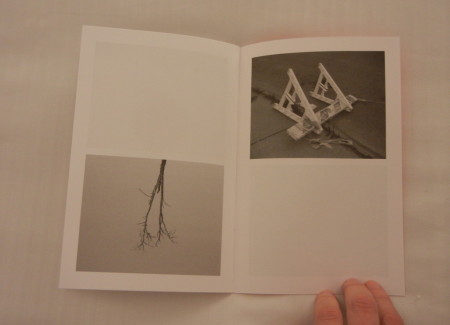JTF (just the facts): Published in 2013 by The Ice Plant and Spaces Corners (here). Saddle stitched, 24 pages, with 24 black and white photographs. Includes a small signed black and white print (numbered and with a drawing), which also serves as the location for the publication information; there are no texts in the main body of the book. (Spread shots below.)
Comments/Context: At first glance, with its simple, saddle stitched binding and spare type on deer hunter orange cover, Ed Panar’s Nothing Changes If Nothing Changes looks like any number of small zines being published these days. But don’t be fooled by its humble appearance – it’s a bold example of innovative photobook sequencing and design, at once lighthearted and formally rigorous.
Just a few pages into the book, you’ll notice something odd about the layout. Panar’s black and photographs are placed in the upper right hand corner of each spread, and upside down images are placed in the lower left, so for each page turn, the viewer gets one image oriented up and one oriented down. When you get to the back of the book, you’ll notice the back cover is the same as the front cover, only flipped over, so you turn the book around and move back through the images in the other direction, the once upside down images now right side up and vice versa. Panar’s book is designed to work both backwards and forwards, in an endless loop; it’s at once mystifying and brilliantly elegant.
Panar’s photographs are filled with small moments of formal clarity, the angles of a plastic bathtub meeting a wall, the linear spread of streetlights on a vertical telephone pole, or the jagged geometries of a tiled staircase becoming sculptural events. This sense for elemental form allows each image to function both up and down, where snow covered trees become dropping triangles and a curtained window is transformed into an inverted V (depending on your perspective); each texture, from the lines of a sidewalk to the roughness of tree bark is both specific and abstracted. The triangles of a fallen construction barrier echo the silhouette of a single tree, the shapes turning around one another like a carousel. I found myself paging through the book again and again, seeing the seemingly simple compositions of a tire, a wooden stool, a puddle, or a dented pillow transformed with each twist of the book.
The book’s title is the final puzzle. Its statement that nothing changes if nothing changes is proved patently false, as even though the book itself has not changed, when turned around, each photograph becomes something surprisingly new. While Rodney Graham’s upside down trees get at this same conceptual issue, the elegant simplicity of Panar’s book creates more of a permanent loop of reconsideration. It’s not just a one off upending of expectations, but a more systematic reexamination of how photographs function.
Collector’s POV: There is no information on the artist’s website about any gallery representation arrangements Panar may have, so interested collectors may want to follow up directly.












I suppose Panar thinks highly of himself based on the ridiculous high prices he’s set for his books. I don’t see what the fuss is all about. It seems that he has set his standard far too high for the majority of people to be able to admire his work. So be it…